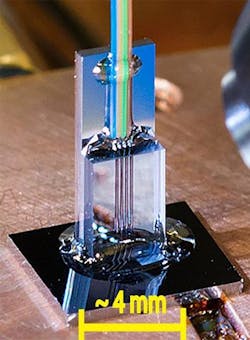NIST finds that silicon photonic sensors can survive high radiation doses without damage
National Institute of Standards and Technology (NIST; Gaithersburg, MD) researchers have published research test results that demonstrate how silicon photonic sensors can be used in high-radiation environments and to advance important medical, industrial, and research applications.
Photonic sensors convey information with light instead of electric currents in wires. They can measure, transmit and manipulate streams of photons, typically through optical fibers, and are used to gauge pressure, temperature, distance, magnetic fields, environmental conditions and more. They are attractive because of their small size, low power consumption and tolerance of environmental variables such as mechanical vibration. But the general consensus has been that high levels of radiation would modify the optical properties of their materials (like silicon), leading to incorrect readings.
So NIST launched a program to address those concerns and found that the sensors could be customized for measuring radiation dose in both industrial applications and clinical radiotherapy. The results of its first round of testing are reported in Nature Scientific Reports.
Specifically, the NIST results suggest the sensors could be used to track levels of ionizing radiation (with energy high enough to alter the structure of atoms) used in food irradiation to destroy microbes and in medical device sterilization--estimated to be a $7 billion annual market in the U.S. alone. The sensors also have potential applications in medical imaging and therapy, which together are projected to total nearly $50 billion in annual value worldwide by 2022.
"When we looked at publications on the subject, different labs were getting dramatically different results," said project scientist Zeeshan Ahmed, who is part of NIST's Photonic Dosimetry Project and leader of NIST's cutting-edge Photonic Thermometry Project. "That was our main motivation for doing our experiment. Another motivation was the growing interest in deploying photonic sensors that can function accurately in very harsh environments, such as close to nuclear reactors, where radiation damage is a major concern," Ahmed said.
The team found that oxide-coated silicon photonic devices can withstand radiation exposure up to 1 million gray, using the SI unit for absorbed radiation. One gray represents one joule of energy absorbed by one kilogram of mass, and 1 gray corresponds to 10,000 chest X-rays. This is roughly what a sensor would receive at a nuclear power plant.
Because this is the upper limit of what calibration customers care about, the devices can be assumed to work reliably at industrial or medical radiation levels that are hundreds or thousands of times lower. Food irradiation, for example, ranges from a few hundred to a few thousand gray, and is typically monitored by its effects on pellets of alanine, an amino acid that changes its atomic properties when exposed to ionizing radiation.
To determine the effects of radiation, the NIST researchers exposed two kinds of silicon photonic sensors to hours of gamma radiation from cobalt-60, a radioactive isotope. In both types of sensors, small variations in their physical properties change the wavelength of the light that travels through them. By measuring those changes, the devices can be used as highly sensitive thermometers or strain gauges. This remains true in extreme environments like space flight or nuclear reactors, only if they continue to function properly under exposure to ionizing radiation.
These sensors will also be of great interest to clinical medicine, in which physicians strive to treat cancers and other conditions with the lowest effective levels of radiation focused on the smallest dimensions to avoid affecting healthy tissue, including electron, proton, and ion beams.
Reaching that goal demands radiation sensors with extraordinarily high sensitivity and spatial resolution. "Eventually, we hope to develop chip-scale devices for industrial and medical applications that can determine absorbed dose gradients over distances in the range of micrometers and thus provide unprecedented detail in measurements," said project scientist Nikolai Klimov.
The team's results may have large implications for new medical therapies that use extremely narrow beams of protons or carbon ions and medical sterilization processes that use low-energy beams of electrons. Because the NIST sensors are naturally small and chip-scale, they are expected to satisfy more applications than current dosimeters on the order of millimeters to centimeters that can give erroneous readings for fields that vary over those dimensions.
In the next stage of the research, the team will test arrays of sensors simultaneously in identical conditions to see if variations in dose over small distances can be resolved.
SOURCE: NIST; https://www.nist.gov/news-events/news/2018/11/photonic-radiation-sensors-survive-huge-doses-undamaged
About the Author

Gail Overton
Senior Editor (2004-2020)
Gail has more than 30 years of engineering, marketing, product management, and editorial experience in the photonics and optical communications industry. Before joining the staff at Laser Focus World in 2004, she held many product management and product marketing roles in the fiber-optics industry, most notably at Hughes (El Segundo, CA), GTE Labs (Waltham, MA), Corning (Corning, NY), Photon Kinetics (Beaverton, OR), and Newport Corporation (Irvine, CA). During her marketing career, Gail published articles in WDM Solutions and Sensors magazine and traveled internationally to conduct product and sales training. Gail received her BS degree in physics, with an emphasis in optics, from San Diego State University in San Diego, CA in May 1986.
